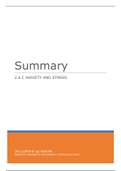Summary
2.6 C ANXIETY AND STRESS
Jim Leferink op Reinink
ERASMUS UNIVERSITY ROTTERDAM | PSYCHOLOGY BA-2
,Problem 1: Stress
A: Your body under stress
What is stress and how can we measure it?1
Stress is the circumstance in which transactions between the person and the
environment lead a person to perceive a discrepancy between the physical or
psychological demands of a situation and the resources of his or her biological,
psychological or social systems (generally, demands exceed resources). Note that
a demand, resource or discrepancy may be either real or just believed to exist.
The condition of stress has two components: physical (direct bodily challenge) and
psychological (how individuals perceive circumstances in their lives). These
components can be examined in three ways:
o Stress as a stimulus (external, environmental forces), involving physically
or psychologically challenging events or circumstances called stressors.
o Stress as a response (internal, people’s reactions to stressors), involving
the psychological and physiological response to stressors called strain.
o Stress as a process (relation between person and environment), involving
continuous interactions and adjustments with the person and environment,
called transactions.
Stress transactions involve an assessment process called cognitive appraisal:
o Primary appraisal determines whether a demand threatens a person’s
physical or psychological well-being. If a person appraises an event as
stressful, he or she may either consider it as a harm-loss (damage already
occurred), threat (future damage to be expected) or challenge (using
extensive resources to meet demand).
o Secondary appraisal refers to the assessment of the resources we have
available for meeting the demand. If we appraise demands as greater than
resources, this may induce a greater deal of stress.
Stress can be measured physiologically or psychologically. Physiological measures
mostly include assessment of physiological arousal, such as changes in blood
pressure and heart rate. Blood and urine can be tested for stress hormones such
as cortisol and adrenaline. Psychological measures include surveys of people’s
experience of life events, daily hassles and experience of chronic stressors.
1 Sarafino, E. P. (2014). Stress - It's meaning, impact, and sources. In: E. P. Sarafino (Ed.). Health Psychology:
Biopsychosocial interactions (pp. 55–79). John Wiley & Sons, Inc. New York: Wiley.
1
, How does the bodily stress reaction work?2
The stress response has a dual nature,
consisting of adaptive changes in the short
term (adrenal medulla) and possibly
maladaptive changes in the long term (HPA-
axis). When a stressor acts on an individual,
two systems are activated:
o Stressors activate the sympathetic
nervous system, thereby increasing
the amounts of adrenaline and
noradrenaline released from the
adrenal medulla. This creates a short-
term fight-or-flight response.
o The hypothalamus-pituitary-
adrenal (HPA) axis stimulates the
release of adrenocorticotropic
hormone (ACTH) from the anterior
pituitary, which in turn triggers the
release of glucocorticoids (cortisol)
from the adrenal cortex.
Stress responses are not uniform, but are
complex and varied depending on the
stressor, its timing, the nature of the
stressed person and how the stressed
person reacts to the stressor.
2 Sarafino, E. P. (2014). Stress - It's meaning, impact, and sources. In: E. P. Sarafino (Ed.). Health Psychology:
Biopsychosocial interactions (pp. 55–79). John Wiley & Sons, Inc. New York: Wiley.
Pinel (2014). Introduction to Biopsychology. Chapter 17: Biopsychology of Emotion, Stress, and Health. Pearson
(pp. 462–463).
2
, What is the general adaptation syndrome?3
Hans Selye (1956) discovered a series of bodily reactions to long-lasting stressors
beyond the general fight-or-flight response. This series of physiological reactions
he called the general adaptation syndrome (GAS), which consists of the
following three stages:
o Alarm reaction. Sympathetic nervous system mobilises the body’s
resources for an emergency (fight-or-flight response). Later, the HPA axis
triggers the release of cortisol into the bloodstream, further enhancing the
body’s mobilisation.
o Stage of resistance. If a strong stressor continues, the HPA axis starts to
dominate the stress response. Physiological arousal remains high and the
body tries to adapt to the stressor; however, eventually the state of
heightened arousal may lead to health problems.
o Stage of exhaustion. The long-term and repeated stress weakens the
immune system and depletes the body’s energy reserves until the ability to
resist may collapse.
The cumulative amount of strain over time, called allostatic load, typically has a
greater influence on health than the degree of activation in response to any one
stressor. This allostatic load reflects the overall amount of bodily activation or
physiological stress, which is influenced by the amount of exposure (frequency,
intensity and duration of stressors), the magnitude of reactivity (individual
differences in physiological and psychological reactions to stressors), the rate of
recovery (e.g., mentally revisiting a stressor after it is over can delay physiological
recovery) and resource restoration (e.g., sleep deprivation can be a source of
stress and contributes to allostatic load directly).
3 Sarafino, E. P. (2014). Stress - It's meaning, impact, and sources. In: E. P. Sarafino (Ed.). Health Psychology:
Biopsychosocial interactions (pp. 55–79). John Wiley & Sons, Inc. New York: Wiley.
3




